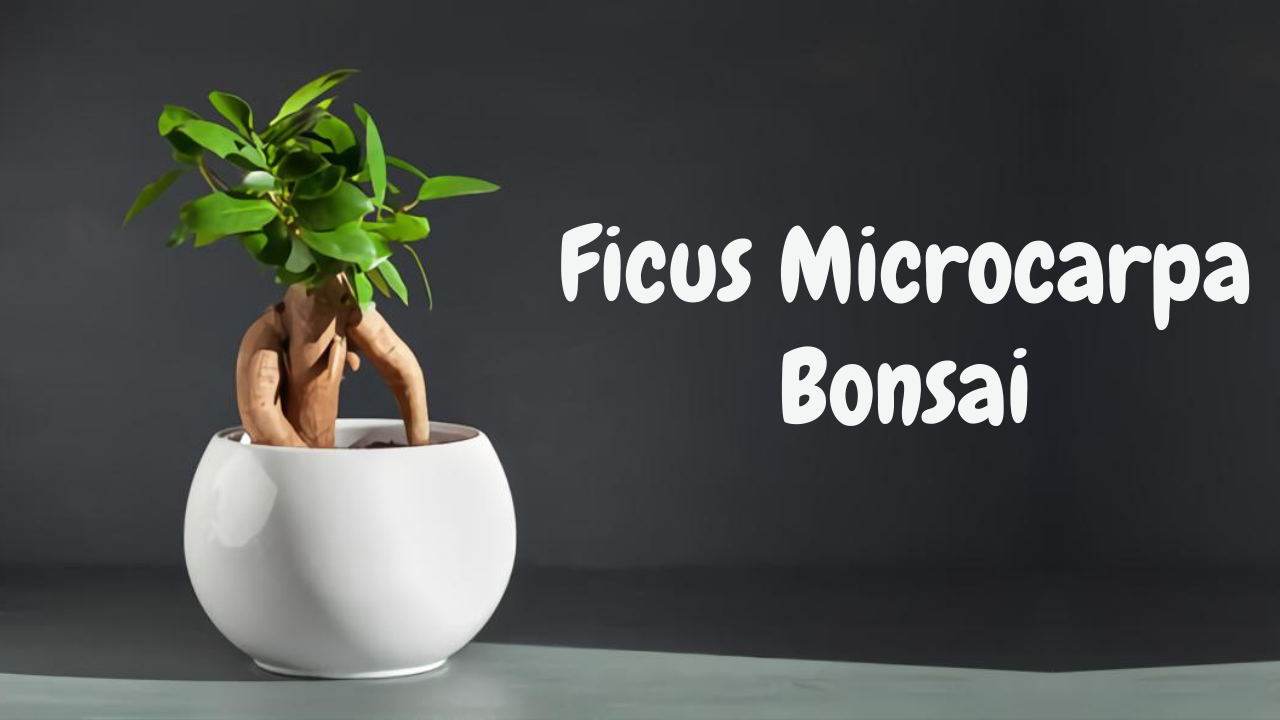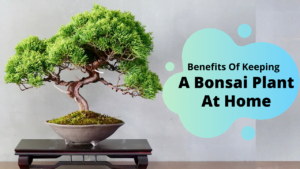Are you also stunned by the aerial roots of Ficus Microcarpa?
Or its oval-shaped leaves forming a beautiful dark green cluster?
Whatever the reason is, Ficus Microcarpa bonsai is adored by all! We have included everything you need to know about this bonsai, its varieties, a care guide, and other necessary details.
Before the further delay, let’s get straight into the varieties.
Ficus Microcarpa Varieties
They come in a variety of shapes and sizes. They usually differ in leaf size, leaf shape, leaf thickness, bark color, and other characteristics. Nature is a creative force, and breeders have discovered many appealing varieties.
Some Ficus microcarpa variants are particularly impressive:
Ficus microcarpa (Green Island)
It has small, circular leaves about an inch across (2.5 to 3cm). It’s ideal for bonsai cultivation.
Ficus microcarpa (Green Emerald)
It has small pointed-oval leaves. They are about an inch and a half long, approximately 3 to 4 cm. This variant is perfect for bonsai.
Ficus microcarpa (Tiger bark)
It has magnificent patterns on the bark and roots when exposed to air. It is an excellent pick for bonsai cultivation, though the attractive bark patterns diminish with age.
Ficus microcarpa (Moclame)
It is different from the rest as its leaves resemble figs or drops with a rounded tip and grow in clusters. It is best developed into a mid-size houseplant with a tree-like stem and bushy leaf ball, measuring 1 to 2 feet tall (30 to 60cm). One can easily weave or braid its stems.
Before jumping into the ficus microcarpa plant care, let’s get to know about the plant itself.
Ficus Microcarpa Specifications
| Plant type | Shrub tree |
| Family | Moraceae |
| Native | Southeast China, Japan, Philippines, Taiwan, Indonesia, North Australia |
| Difficulty Level of cultivation | Beginner-friendly |
| Size | Indoors not more than 1.5 m Outdoors up to 25 m high. |
| Growth rate | Moderate |
| Lifespan | Perennial |
| Temperature | In the summer: 18-23°C, in winter, not below 16°C. |
| Bloom | Small round blossoms of purple color about 2 cm in size, similar to berries. |
| Soil | Indoor plant soil mix, well-drained |
| Exposure | Indirect but luminous |
| Foliage | Evergreen |
| Watering | Moderate |
Ficus Mircoparca Care isn’t complex. It is beginner-friendly and is easy to care for. Apart from its pruning and watering, it won’t give you much trouble.
Here, we will discuss everything in detail about the Ficus Mircoparca bonsai care.
Ficus Mircoparca Care
Temperature
As you know, the Ficus Microcarpa is a tropical plant, and it is familiar with warm humid conditions. If you are growing your ficus bonsai indoors, they will do wonders in temperatures ranging from 60 to 75 degrees Fahrenheit all year.
If you are stumbled upon whether you should plant it indoors or outdoors, we suggest planting indoors would be an ideal choice. Although, allowing your bonsai to breathe some time outside is also beneficial.
As they flourish well in warm temperatures, Place them in an area that receives plenty of bright, indirect light. It makes them ideal for shaded areas, such as a patio with a cover. It’s time to bring them back in when the temperature drops below 60 degrees.
Note for Ficus Microcarpa Care:
- They don’t prefer wind gusts and drafts. It may lead to the falling of leaves. Ensure to keep them away from such elements.
- You should keep ficus bonsai away from heaters and air conditioners that produce hot or cold drafts.
Humidity
Ficus microcarpa bonsai care includes high humidity, and it may or may not be sufficient depending on where you live.
Here we have suggested a few options for increasing relative humidity if need to.
1) You can spray room temperature water around the plant every now and then. It will aid the ficus bonsai to keep the air surrounding it moist. It, however, will only be temporary. As a result, you’ll need to mist a couple of times per week.
2) You can also place your bonsai on a pebble tray. It is one of the most preferred methods people follow, as it is “hands-off” and free. All you need to do is place the pot on top of pebbles in a water bath. To avoid getting the bottom of the pot wet, keep it above the water. As the water evaporates, it adds moisture to the air around the ficus plant, raising humidity levels.
Note: You have to refill the basin when the water level falls below a certain level, though it will take time.
3) Get your bonsai some friends. Combine it with other plants in a group. Plants transpire. Moisture evaporates from the plants’ leaves, resulting in increased humidity in the air.
4) One of the most efficient ways is current humidifiers, as they permit you to select a specific target humidity level. If the air becomes too damp or dry, it turns off or on. You can precisely control the humidity and maintain it over time. However, it will cost you handsomely.
Lighting
Ficus microcarpa bonsai care includes bright but indirect light. It won’t be able to withstand direct sunshine during the hottest hours. It’s recommended to use indirect lighting.
If you plan to grow your bonsai indoors, keep it out of direct sunlight, especially during the hottest parts of the day, which are around noon to mid-afternoon, as it might burn the leaves.
Note for placing Ficus microcarpa bonsai:
- Ficus microcarpa plant care involves avoiding the shady or dark areas for placement. It will not be able to thrive well in such conditions.
- When picking an ideal location for your bonsai, an east-facing window is the one for you. It receives a lot of brilliant morning light, and not too much resulting in the perfect atmosphere.
- You can also opt for south and west-facing windows because they provide abundant natural light. However, you should keep an eye on it to observe how it responds to the mid-afternoon sun. If your bonsai starts to demonstrate signs of distress, then ficus microcarpa bonsai care is a must. Ensure to move it away from the window or use curtains or drapes to obstruct the light.
Soil
The best part of ficus microcarpa bonsai care is it isn’t picky about the soil it grows in. In fact, any soil mix will suffice as long as it is well-draining. The only thing you need to care about is that it dislikes sitting in water. As a result, you can use a potting mix that doesn’t carry too much moisture.
Though, you can use any garden soil. You may miss out on the minerals and organic matter found in the soil. If you don’t have a lot of organic matter in your garden soil, you can decide everything on your own from scratch. With potting soil, you get to choose the substrate(s) you wish to utilize to make the ideal soil you want. Also, choose the sort of fertilizer to tailor everything for the best outcomes.
Watering
When it comes to ficus microcarpa plant care, watering is by far the most crucial consideration. As a result, this part is a little longer than the others.
The right ficus microcarpa bonsai care will inform you if you’re watering it correctly or not. If you do things in the correct way and conditions are favorable, it will sprout aerial roots. It is the tree’s most distinguishing feature. It’s also what draws a lot of people to it.
As we mentioned earlier, the bonsai plant thrives in a damp and moist climate. It’s critical to give it a full, deep watering and then wait until the soil has dried slightly before watering again. While it may endure a lack of or excessive watering for a short length of time, it will soon demonstrate indications of discomfort.
Note for Ficus Microcarpa plant care:
- When watering, it is very susceptible to harsh water, so keep that in mind. Tap water is not the best idea for your plant to drink as it contains chemicals and minerals. You should use soft water, which is low in chemicals and minerals, filtered or distilled water.
- Rainwater is the most acceptable option because it is chemical-free and all-natural.
Watering your bonsai plant involves making specific changes according to different seasons. We will guide you on the water requirements of your bonsai.
Watering Ficus Microcarpa in Summer
Summer and spring seasons are known as active growing seasons. As a result, your microcarpa bonsai will consume more water at this time.
- Ensure to test the soil during this time constantly. There are no established hard rules to follow here; instead, use a literal “rule of thumb.” Stick a fingertip in the soil up to the first knuckle, and if it still feels moist, don’t water.
- Depending on how dry the air is, it could be once every three to four days up to once every ten days.
- You will need to water your ficus bonsai plant more frequently due to the warm weather, growth spurt, sunlight, and air. However, you should strictly avoid letting too much water gather in the roots. Allow it to drip until completely dry before replacing it on its saucer.
- The plant will survive with irregular watering if you find approaches to boost air moisture.
- Get yourself a pot with holes at the bottom for your ficus bonsai. It works best. When you water your ficus bonsai, make sure to water well until the liquid seeps out the bottom. Then, always allow excess water to drain.
Watering Ficus Microcarpa in Winter
In the winter season, the growth of the plant is considerably slow. As a result, it will use a lot less water. The weather will also be colder, resulting in significantly less evaporation.
- It necessitates less regular watering. Before watering, use the same rule as before and test the soil. You’ll see a pattern after a while. Typically, it happens once every two weeks or so.
- Avoid using cold water right from the tap is not a good idea. You should pour some into a jug and place it near the pot with the cap open for a few hours. It will help to exhaust any chlorine and elevate the temperature to prevent the ficus bonsai plant from experiencing a thermal shock.
Note: Water your bonsai once every two weeks at most.
Fertilizer
Your ficus bonsai, like soil, isn’t fussy about fertilizer. Isn’t that good news for you? All you need is a half-strength balanced or all-purpose houseplant fertilizer. Either way, your bonsai will be delighted. You can use liquid fertilizer, alternating organic and mineral. So, decide which one you prefer to use.
One of the most essential in ficus microcarpa bonsai care is when to feed it and when not to.
- You should feed once a week or every two weeks during the growing season (spring and summer) of your bonsai.
- Similarly, you should reduce your workload in the fall and winter. You can feed it every two to four weeks if it continues to grow during this time.
- However, if growth slows or stops entirely, quit fertilizing and restart in the spring.
Note for ficus microcarpa plant care: Make sure not to feed your bonsai when it is sick.
Reproduction
- Take upper cuttings 10 cm, at least with three pairs of healthy leaves of the plant.
- Plant it at a temperature of 25°C in a combination of peat and perlite or with sand.
- Now, put it for germination in diffuse sunlight.
- One month later, tilt the stems a little bit and check whether the roots formed.
- If the plant’s roots have emerged, it is necessary to remove all the leaves except the upper pair.
- Now, after 14 days, you can feed the plant a little with diluted fertilizer.
- Place it in a pot of about 12 cm in diameter after three months of rooting.
Note: It can also be propagated by layers, root offspring, and seeds.
Ficus Microcarpa Pruning and Trimming
Pruning is necessary for bonsai trees and plants. It’s what allows them to maintain their small, compact size. It’s also what gives them a tidy, well-kept appearance.
The ficus bonsai can grow quite large in the wild in tropical areas, but keep it modest for the best effect in your home.
It can sprout new sprigs directly from the trunk’s bark. Due to this, you should trim your bonsai well and avoid mistakes at all costs.
Ficus Microcarpa Regular Pruning
This ficus Microcarpa bonsai pruning strategy is a continuous process of trimming. You can trim back 2 of the new leaves whenever you see 5-8 new ones develop. This way, you can easily maintain its shape.
- The bonsai plant will be happy to develop new twigs and leaves.
- Try to keep the plant covered all around, like an umbrella atop the root trunk, by balancing growth.
- Make sure to rotate the plant so that you aren’t only chopping on one side. Otherwise, the shape of your ficus bonsai will become uneven.
Note for ficus microcarpa bonsai pruning: The only disadvantage of this strategy is that it necessitates more work because you must trim frequently. On the other hand, your plant will always appear beautiful since it is well-kept.
Ficus Microcarpa Seasonal Pruning
This ficus microcarpa bonsai pruning strategy requires you to wait until spring. Spring is the optimal time to prune because the weather and season are conducive to growth. It will be ready to sprout new, healthy growth whenever you chop the tree.
As you’ll only be pruning once or twice a year, depending on how dense you want your plant to be, you’ll be allowing the leaves to grow out more than with the prior procedure.
- You can reduce the size of the branches by a third or even half.
- Cut off any sprouts that may be developing from below the graft joint if they don’t please you.
- As you will be cutting leaves infrequently, they will be more and heavier. It usually entails trimming the branches down by around 33% to 50% at a time.
- When pruning, feel free to defoliate (or remove the leaves). Do not panic in this situation. New leaves will grow back!
Note for ficus microcarpa bonsai pruning:
- The only disadvantage is that as your ficus bonsai becomes larger, it may become undisciplined and “out of shape.” You can also give your bonsai wounds by cutting larger branches.
- Seasonal pruning is more suitable for Ficus bonsai trees that are wire-trained into bonsai.
Ficus Microcarpa Transplanting and Repotting
If you are concerned about ficus microcarpa care, you have to be more careful while transplanting and repotting. It, in general, dislikes being moved. If you have found a convenient place that meets all the requirements your bonsai needs, it’s better to leave it alone.
Regardless, you need to repot your ficus bonsai in 1 to 3 years.
Things to keep in mind while ficus microcarpa bonsai care:
- It’s a good idea to relocate it to a larger container whenever it outgrows its current one. If you don’t, you will be more likely to stunt your plant’s growth.
- Apart from that, as the roots try to accommodate a small area, they will twist and become rootbound. Moving your bonsai to switch to a larger pot will allow you to give them new potting soil.
- Make sure to inspect the roots before repotting. It is the ideal time to keep an eye on it and trim or address any issues that arise.
Note for ficus microcarpa plant care: As we mentioned earlier, the ficus bonsai plant, like other figs, loathes being moved or placed in a new habitat. You can witness some leaves fall owing to changes in light, weather, watering, and so on. Do not panic in those circumstances. However, your bonsai should adapt to new surroundings in around two weeks and begin to develop new leaves.
Whether you are a newbie or an experienced plant parent, you must be very familiar with the pests and diseases that come along with gardening.
Here we will discuss the pests and diseases that can harm your ficus microcarpa bonsai.
Pests
The ficus microcarpa is relatively pest-resistant. As a result, ficus microcarpa care becomes less of an issue, especially if your plant is healthy and in good shape. However, lack of sunshine, over-or underwatering, and improper temperature or humidity can worsen your bonsai.
These awful conditions are most common during the winter when rays are sparse and the weather changes, making the air dry. Your ficus bonsai may become infected due to its fragile state.
Spider mites, whiteflies, aphids, shields, thrips, and scale are the most common. Whenever there is too much wind or water, the leaves of the ficus can turn yellow or fall off. In this case, ficus microcarpa care involves relocating it to a location where it can thrive in the winter.
Now, let’s encounter some of the diseases that can hurt your ficus bonsai plant.
Diseases
If your bonsai encounters these diseases, you should take immediate steps for your ficus microcarpa plant care.
- Your Ficus microcarpa leaves may become brittle and break off due to insufficient hydration or excessive wind in that location.
- Your leaves can also change their color or turn to yellow due to too much watering and/or inadequate drainage. It can also lead to the falling of leaves.
You should allow the soil to dry before watering again, check drainage, then amend the potting soil with sand. The plant usually acclimates to the changing environment after 1-2 weeks.
Note for ficus microcarpa care: If your soil has excessive moistening, it can cause the falling of green leaves.
When we are growing ficus microcarpa bonsai, you need to consider a few things while cleaning it. It will help the bonsai to thrive well.
Cleaning and Misting Ficus Microcarpa Leaves
You can bring your Ficus microcarpa to the sink and mist its leaves with mild water every now and then to clean. There is no hard and fast rule for that.
- You can remove dust and bug residues with a soft square of cloth (ideally cotton) from time to time.
- The cloth should have a size of the width of your hand.
- You should wrap your fingers around the cloth to keep the falling tips from hooking on branches.
Increasing local air moisture can do wonders as well. They’ll keep you from needing to mist as frequently.
Conclusion
Ficus Microcarpa thrives well in warm and humid conditions. The ficus microcarpa plant care is beginner-friendly, and anyone can grow this bonsai at home. All you have to do is be a little cautious while watering and pruning!
Apart from that, it will light a green lamp in your house!
Related Articles
- Bonsai for Beginners in India [Update 2024]
- 15 Best Plants for Front Door Entrance India | Auspicious plants for front door
- 10 Study Table Decoration Ideas That Will Make You Love Learning
- Revive Your Bonsai Tree with These Proven Techniques!
- Top 15 Benefits of Bonsai Plants that will Make your Life Awesome
- Top 10 Indoor Plants for Cafes to Enhance Decor & Comfort







